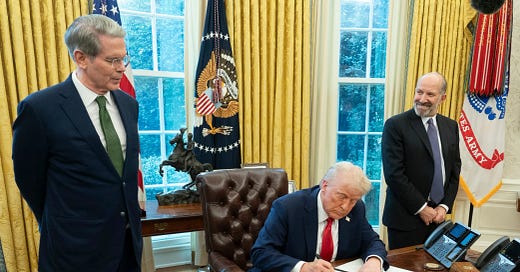Thoughts on the U.S.'s Nascent Sovereign Wealth Fund
This is a great move by the Trump Administration. Hopefully one that Congress acts on.
The Trump Administration’s announcement today of paving the way for a U.S. sovereign wealth fund (SWF) represents a transformative and long‐anticipated shift in American fiscal policy. I have long argued that the United States, like Norway, the United Arab Emirates, Singapore and China, should leverage surplus revenues to secure a more stable economic future and extend American influence abroad.
SWFs work by taking excess revenues, typically from natural resource exports or budget surpluses, and investing them in a diversified portfolio (stocks, bonds, infrastructure, real estate, etc.) to generate long‑term returns. For example, Norway’s Government Pension Fund Global has not only provided a buffer against volatile oil prices but has also helped stabilize public finances and fund key national projects.
Critics often claim that the absence of an SWF in the United States is due to its democratic and non-monarchical structure. However, this argument is undermined by the fact that even democracies with robust representative institutions (such as Norway) have successfully established SWFs. An SWF can serve dual purposes: it can fortify the nation’s financial position and, through strategic international investments, extend U.S. influence by aligning economic interests with partner nations.
The first question that comes to mind is: how do we know that the fund—and its managers—will succeed? The easy answer is that the United States boasts one of the world’s largest financial sectors, attracting some of the brightest minds to its capital markets. By endowing the fund’s management with genuine decision-making authority and establishing the position as a prestigious one, we can expect to recruit some of the world’s best investment professionals. Of course, the fund wouldn’t operate exactly like a private firm, but the principle is the same: identify investment opportunities that generate a stable, long-term return for the nation. States and pension funds already do this effectively. For example, when I was a teacher, a portion of my monthly paycheck went into the Texas Teachers Retirement System Fund, which managed our money to provide reliable returns at retirement. The same strategy should be applied at the national level.
The United States faces serious financial challenges—our budget is persistently unbalanced, and the deficit grows year after year. While some, like DOGE, claim they are addressing these thorny issues, establishing a sovereign wealth fund would be a boon for the country, further cementing the financial strength of the world’s greatest nation. Moreover, the SWF could invest in public markets, giving US companies a boost by providing access to a broader range of resources. Of course, strict rules must be put in place to ensure that companies cannot lobby or exert undue influence over the fund’s management. If prudently managed, however, a sovereign wealth fund could serve as an outstanding source of long-term wealth for the United States.
The second key benefit is the ability to project confidence abroad by using the SWF as a vehicle for strategic foreign investment—especially in undervalued markets in regions like South America and Africa. By channeling investments into these emerging economies, the United States can help spur their development, generating goodwill and strengthening bilateral ties. Moreover, such engagement prevents these vulnerable markets from falling into the clutches of rival powers, such as China, whose interests and values may differ significantly from our own. If we allow a vacuum to form when we eventually step away, it risks being filled by a nation that does not uphold our cherished principles of freedom, democracy, and merit.
A pivotal legal question is whether President Trump can unilaterally establish such a fund by redirecting tariff revenues, especially using emergency powers. Although Congress has never specifically addressed this issue, proponents might argue that the nation’s deepening fiscal imbalance and economic instability constitute an “unusual and extraordinary threat” under the International Emergency Economic Powers Act (IEEPA), codified at 50 U.S.C. §§1701–1707. Under IEEPA, the president is granted broad authority to take measures necessary to confront emergencies that originate outside the United States. Legal precedent shows that emergency powers have been invoked in contexts ranging from national security to economic crises.
However, this argument would not be without its challenges. The Supreme Court has long reaffirmed Congress’s “power of the purse” and the limits of unilateral executive action, as notably articulated in Youngstown.1 That decision makes clear that even in emergencies, the president’s authority cannot usurp the constitutional prerogative of Congress to decide how public funds are spent. In other words, while no law expressly forbids redirecting tariff revenues, doing so via emergency powers would likely be challenged as an overreach that disrupts the longstanding balance of power between the branches of government.
In short, if President Trump can successfully argue that the country’s worsening fiscal crisis qualifies as a national emergency under IEEPA, then redirecting tariff revenues into a sovereign wealth fund might be justified as an extraordinary measure to safeguard the nation’s future. Such a fund would not only stabilize the U.S. economy but also project American strength abroad by investing in strategic markets. Yet any move in this direction would undoubtedly face intense scrutiny from Congress and the courts, given the historical limits on unilateral executive action and the constitutional mandate for congressional oversight of public funds.
Ultimately, this initiative could be a groundbreaking step for America, one that harnesses surplus revenues to create long‑term wealth and strategic influence, provided it is managed with the utmost prudence and within the constitutional framework.
Youngstown Sheet & Tube Co. v. Sawyer, 343 U.S. 579 (1952).




